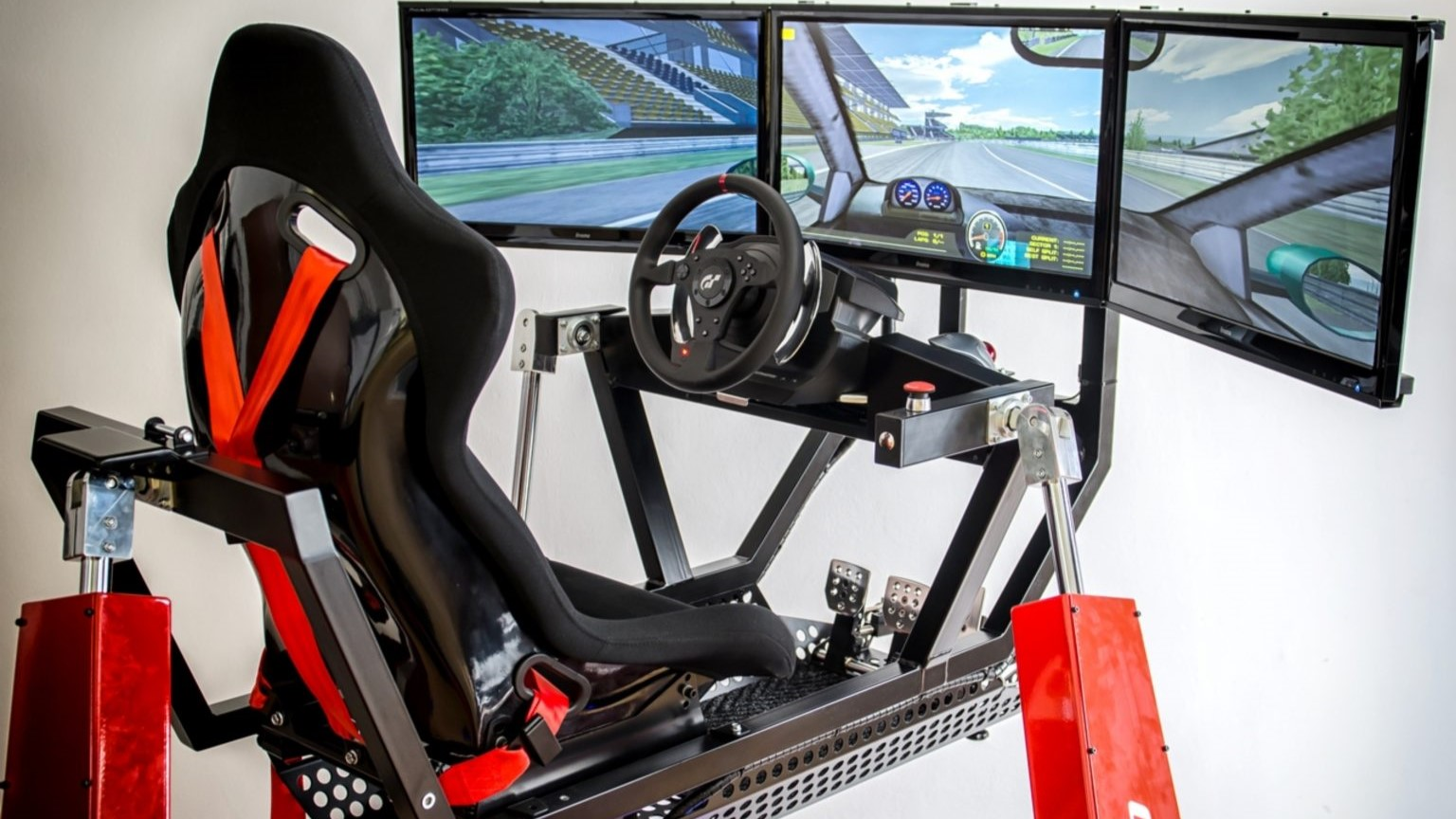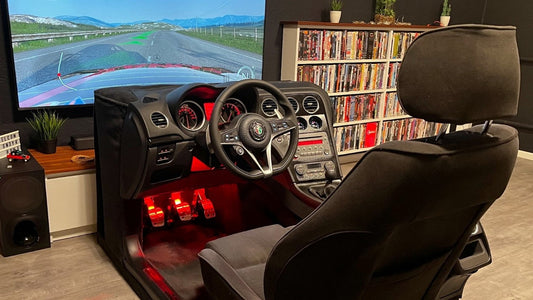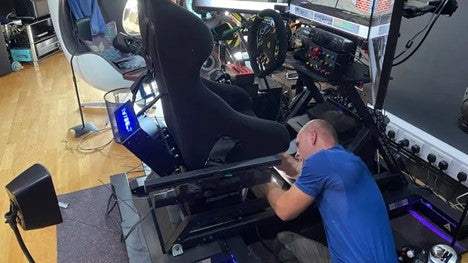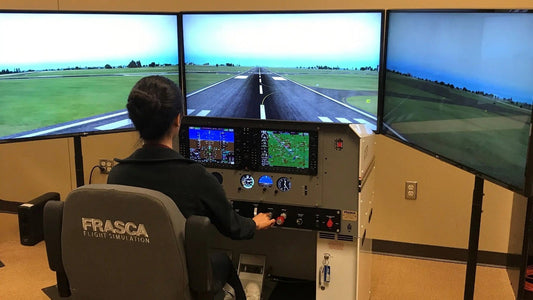Building vs Buying Racing Simulators – All You Need to Know

Figure 1: A Racing Simulator Setup
Building your own DIY sim racing rig is an exciting venture but can soon turn into a nightmare without proper knowledge of assembling and handling components. On the other hand, buying a prebuilt sim racing setup is a much more convenient choice but can be a quick letdown if it lacks the exact components you want.When deciding between building and buying a racing simulator, there are several things to consider. To name a few, these are your goals, budget, technical expertise, and desired experience. If you are confused about whether to buy a ready-made racing simulator or build one tailored to your preferences, here are some handful tips and insights to help you determine which option might be the best fit for you!
Why Build a Racing Simulator?
Customization Flexibility
 Figure 2: Racing Simulator Components
Figure 2: Racing Simulator ComponentsWhen you build your own racing simulator, you get to have complete freedom in how you proceed with every component in your rig. Right from selecting the cockpit frame that best supports your setup and seat texture that provides the right comfort level to choosing high-performance pedals and equipping a comfortable steering wheel which sits perfectly in your hands, you have full control over your DIY sim racing rig.
This flexibility allows you to create a setup that precisely matches your specific driving style, comfort, and aesthetic. You are no longer limited by the standard configurations of a prebuilt sim racing setup.
Cost Control
 Figure 3: A Person Racing on A Custom-Built Simulator
Figure 3: A Person Racing on A Custom-Built SimulatorFor instance, you can begin with a basic setup and gradually upgrade components over time rather than committing to a hefty upfront investment. And since you have control over your expenses, you can pick components from any manufacturer you like. Unlike traditional prebuilt sim racing setups, you’re not locked into a specific brand or ecosystem, so you can mix and match different parts to create your ideal simulator.
Compatibility with Existing Gear
 Figure 4: Logitech G920 Pedals and Wheel
Figure 4: Logitech G920 Pedals and WheelThis will not only save money by reusing quality gear but also help avoid the redundancy that often comes with prebuilt sim racing setups, where fixed configurations might duplicate equipment which you already have.
For example, if you already have the Logitech G920 sim wheel and pedals, you will be thrilled to know that it works with most major consumer platforms like Xbox Series X|S, Xbox One, Windows, and even Mac! The Logitech G920 is a popular choice among sim racers, especially those who are new to the world of sim racing. Here is one 5-star review on it from Amazon:
The build quality is pretty good the steering wheel is leather with some metal on it. The clamps the wheel comes with could be better but it stays on my desk for the most part. It’s plug and play on pretty much every racing game accept asetto corsa but you can manually map the wheel and pedals on that game and it works fine so no big deal. The force feedback is pretty good it really gives you a sense of speed. The pedals are pretty good for the money. The paddle shifters are pretty nice feeling, pretty good for paddle shifted cars. But eventually I wanted to drive cars that have stick shifters so after a month or so I bought the optional shifter. All that being said won’t go back to using a controller for racing games for sure.
Upgradability

Figure 5: A Modular Custom Built Racing Simulator
A self-built racing simulator is much easier to upgrade. As new technology emerges, you can swap out individual components which become outdated, like pedals, shifters, or even the cockpit frame; and replace them with newer ones without ever needing to overhaul the entire rig. This modular approach means you can gradually add features like advanced force feedback, high-end pedals, or even a VR headset over time if you initially didn’t have these to start with. Learning Opportunity
 Figure 6: A Person Setting Up Simulator Pedals
Figure 6: A Person Setting Up Simulator PedalsThis experience will prove incredibly rewarding as you not only learn how each component contributes to the overall setup but also develop problem-solving skills. If something goes wrong with any of the components in the future, your familiarity with the rig’s assembly and functionality will allow you to troubleshoot and repair minor issues independently; thus saving time and money on professional help.
Pride in Creation
 Figure 7: A Person Showing His Custom-built Racing Simulator
Figure 7: A Person Showing His Custom-built Racing Simulator
Last but not least, building your own racing simulator adds a personal touch to your virtual racing experience. Knowing that every component was chosen and installed by you creates a unique bond with the setup, and the happiness of seeing your DIY sim racing rig perform exactly as you envisioned is unmatched.
Beyond the thrill of racing, building your own rig also instils a strong sense of accomplishment which, in turn, reinforces confidence in your abilities. This achievement can spark optimism and inspire you to take on new challenges whether within the world of sim racing or in future DIY projects.
Why Buy a Racing Simulator
Time Efficiency

Figure 8: A Person Drawing an Upward Efficiency Graph
One of the biggest draws of a prebuilt sim racing setup is that it is a major time saver. With a prebuilt setup, you skip the lengthy process of researching components, assembling parts, and troubleshooting compatibility issues. Instead, you get a fully functional rig that’s ready to go right out of the box.This convenience is especially valuable for those sim racers who do not have enough technical expertise in the field or simply lack the time to dedicate to a DIY build. A ready-made racing simulator, as such, lets you dive straight into the action by offering a hassle-free path to immersive racing without the extra commitment of building and maintaining a rig.
Guaranteed Compatibility
 Figure 9: A Properly Set Up Racing Simulator
Figure 9: A Properly Set Up Racing Simulator
Moreover, when you buy a ready-made racing simulator, you benefit from guaranteed compatibility among all components. This eliminates the risk of compatibility issues that might arise from mismatching hardware or software, which is a common problem with a DIY sim racing rig, especially if you are not a tech-savvy person.
Additionally, most prebuilt simulators come with warranties and dedicated customer support. It provides much-needed peace of mind in the event of any malfunctions or technical issues. In case something goes wrong, you can simply rely on professional assistance to address and resolve them promptly without doing any guesswork or adding the expense of troubleshooting on your own.
Professional Build Quality
 Figure 10: A High-Quality Sim Racing Setup
Figure 10: A High-Quality Sim Racing SetupWhat’s great to know is that prebuilt sim racing setups from reputable companies like Fanatec or Thrustmaster are rigorously tested to ensure quality control. When you buy one of these, you know that you are investing in a product which is built to last and is further backed by the assurance of optimal functionality and resilience!
Optimized Performance

Figure 11: A Person Racing in A Formula Sim Race
Manufacturers always fine-tune their equipment to provide an optimized sim racing experience. They know how to optimize settings for realism, immersion, and comfort for a user. With a prebuilt sim racing setup, each component is carefully selected and calibrated to work seamlessly with others, ensuring maximum performance and efficiency.
This level of optimization can be difficult to achieve on your own if you're building a DIY sim racing rig from scratch. Some components work better when paired with certain components. As a beginner, it’s easy to overlook these technical nuances and this leads to a messy bunch of joined-together components. Your DIY sim racing rig won’t give the optimized performance in games you hoped for and the price you paid for building it up.
Immediate Availability

Figure 12: Prebuilt Simulators For Sale
For those eager to dive into sim racing right away, purchasing a prebuilt sim racing setup allows you to start sim racing almost immediately. Unlike a DIY build, there’s no waiting for individual parts to arrive or dealing with unexpected troubleshooting. Many manufacturers even offer optional assembly services upon delivery that save you both time and effort in getting your simulator up and running. This makes buying a ready-made racing simulator much more appealing for those who want a seamless, stress-free entry into sim racing.
Final Thoughts
In the end, all I can say is that your final decision will ultimately depend on whether you're more inclined to enjoy the process of creating and upgrading, or if you prioritize getting a high-quality racing experience with minimal effort.Remember, only build if you enjoy customization, have the technical know-how, and want a more budget-friendly and upgradable project. If not, then buy a ready-made racing simulator as it is much more convenient, saves you time, and ensures professional build quality for a plug-and-play solution.





